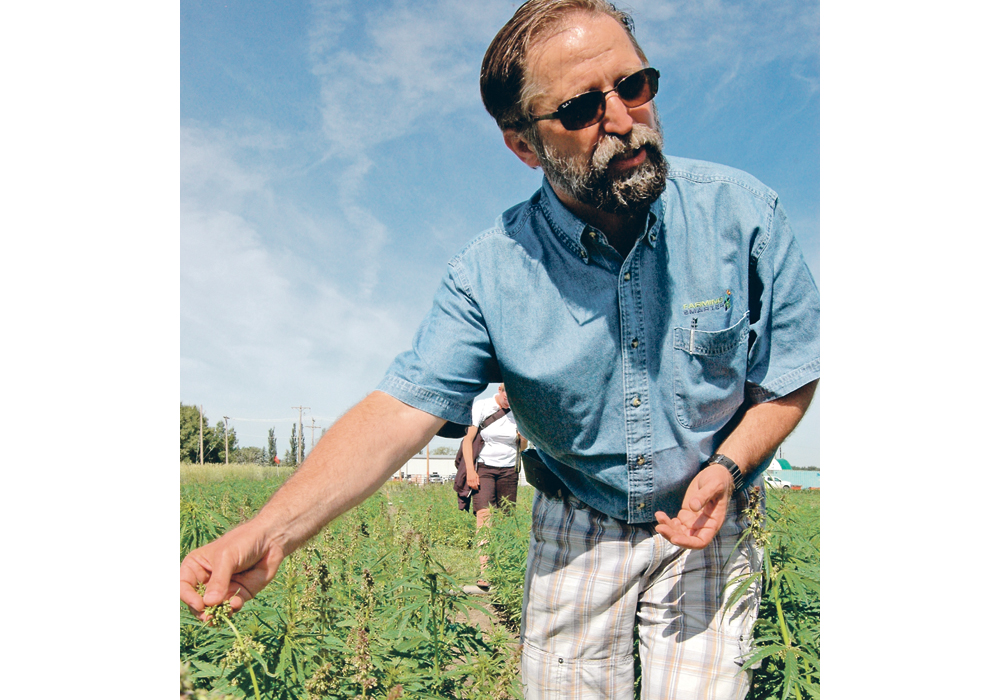The time has come for electric lettuce.
That’s one term that Jan Slaski, hemp expert and senior researcher with InnoTech Alberta, has heard applied to high THC cannabis, the marijuana that produces strong psychological effects on those who imbibe.
But the legalization of marijuana in Canada has also flung open the doors for hemp, the low THC cannabis that can be grown for seed, fibre and cannabidiol production, Slaski told those at the mid-December Farming Smarter conference.
Low THC cannabis, which has less than 0.3 percent THC, was legalized in Canada in 1998 for use as food and fibre. In July 2001, higher THC cannabis was approved for medical use.
Read Also

Farming Smarter receives financial boost from Alberta government for potato research
Farming Smarter near Lethbridge got a boost to its research equipment, thanks to the Alberta government’s increase in funding for research associations.
Full legalization of high THC cannabis as of October 2018 means that industrial hemp could reach whole crop utilization — seed, fibre and cannabinoid (CBD) production, said Slaski.
“Every single part of this plant can (now) be used, can be sold for money,” he said.
As team lead on hemp production and breeding, Slaski has been working for 17 years to improve agronomics and increase production.
There is a market for hemp seed in human food, although Slaski said surveys indicate only four percent of Canadians use hemp seed despite its proven health attributes. That compares to more than 60 percent of Canadians who say they use or have used high THC marijuana.
Markets for hemp fibre have been slow to develop but are gradually gaining ground. An Alberta government hemp fibre facility in Vegreville, established seven years ago, has helped develop various uses for fibre, among them biocomposites for car parts, modular building blocks, hempcrete, paper, packaging and livestock bedding.
Textile applications have brought the development of hemp-based uniforms, socks, underwear and other apparel — clothing Slaski said “is not like a burlap bag” but is of quality suitable for fine textiles.
If hemp’s CBD can also be successfully extracted and marketed, industrial hemp could become a billion-dollar crop, said Slaski.
In 2017, Alberta grew one-third of all the industrial hemp produced in Canada. InnoTech’s agronomy trials are experimenting with seeding dates, seeding rates, optimum fertilizer types and rates, herbicide use and harvest dates to help growers improve production.
The CBD produced in industrial hemp is a psychoactive ingredient, said Slaski, and is non-addictive with proven medical benefits. It has been used to treat post-traumatic stress, epilepsy and other disorders.
Canadian registered varieties of hemp have one to four percent CBD, while some varieties available in the United States contain up to 15 percent.
CBD levels in hemp depend on the crop’s genetics, growing conditions and management.
“If you know how to grow your hemp, if you know how to manage your hemp, you can get … these three revenue streams, from grain, fibre and cannabinoids.”
However, harvesting hemp for CBD is tricky, said Slaski. It is attached to the chaff, so collection depends on the type of equipment used, drying method, storage and methods of extraction.
“Over half of cannabinoids … are lost during post-harvest processing,” said Slaski, mostly due to poor handling and drying. “You have to be very particular.”
With research underway, however, he anticipates industrial hemp will become the major source of CBD.
“We will get varieties in a couple of years that will be having more than three, four, five percent (CBD),” he said.
According to his calculations, 60,000 tonnes of industrial hemp feedstock at 400 kilograms per acre multiplied by three percent CBD would yield 1,800 tonnes of CBD.
As hemp acres increase, as they have in Alberta since 2010, the new model will see 100,000 tonnes of feedstock with 15 percent CBD, which would yield 15,000 tonnes of CBD.
Slaski said the Canada Hemp Trade Alliance now suggests that industrial hemp will be a $1 billion crop by 2023 due to “transformational growth” in the next four years that will see greater use of hemp’s seeds, fibre and CBD.
To achieve that, however, hemp must be legalized for animal feed, consumer awareness of hemp seed benefits must be raised and more organic hemp growers will be needed to meet demand for that production stream, said Slaski.
There is also a need for dual-purpose harvesting equipment and more processing facilities.


















